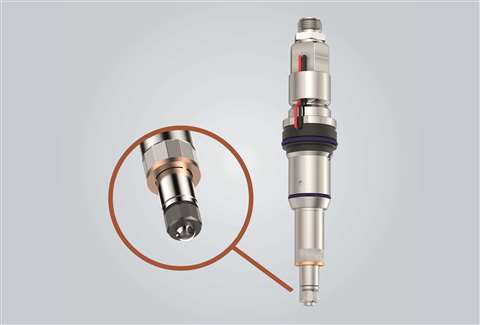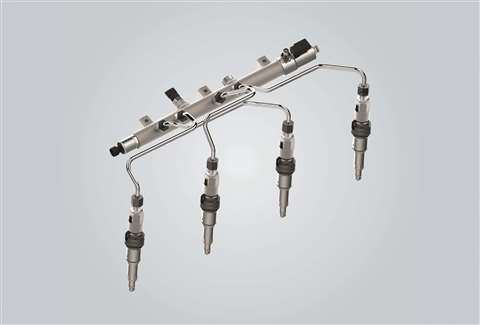Liebherr takes direct approach to H2 fuel systems
22 November 2022
Liebherr Components AG, part of the Liebherr Group, has announced the development of new direct fuel injection systems for hydrogen (H2) combustion engines in heavy-duty applications. The current systems target engines with outputs up to 75 kW (100 hp) per cylinder, but the company is also in development with versions designed for larger engines rated up to 225 kW (302 hp) per cylinder.
 Liebherr has developed a range of direct injection hydrogen fuel injectors for engines with outputs up to 75 kW (100 hp) per cylinder. Versions for larger engines up to 225 kW (302 hp) per cylinder are set to begin testing in 2023. (Photo: Liebherr)
Liebherr has developed a range of direct injection hydrogen fuel injectors for engines with outputs up to 75 kW (100 hp) per cylinder. Versions for larger engines up to 225 kW (302 hp) per cylinder are set to begin testing in 2023. (Photo: Liebherr)
Liebherr noted several challenges for H2 combustion engines, including the ability to operate in less than optimum conditions while maintaining peak power and accommodating dynamic load changes. Being able to approach diesel engines in terms of performance and operating characteristics is perhaps the biggest hurdle for H2 engines, the company said.
To address such issues, Liebherr has taken a system-oriented approach to hydrogen injection that combines various components to control pressure and flow. This enables the same operating characteristics as a diesel while maintaining a sturdy system design, the company said.
The aim of matching the performance of an H2-DI (hydrogen-direction injection) engine to that of a diesel engine requires the system to be capable of ensuring high flow rates. Due to the low density of hydrogen gas, the injector needs large valve cross-sections. To enable a precise control of even the smallest quantities, the system pressure must be regulated with pinpoint accuracy. In Liebherr’s H2 injection system, this is achieved by means of a gas volume control valve. Additional attention is given to minimal nozzle leakage from the injector, with an aim toward making the injector gas tight.
“To achieve the same drivability with a H2 system as with a diesel, the hydrogen injection system must be optimally aligned with the engine’s torque and power,” explained Richard Pirkl, managing director of Technology and Development at Liebherr-Components Deggendorf GmbH. “This means that during the transition from idle to full load, the necessary amount of fuel and the corresponding system pressure must be made available as quickly as possible.”
Low Pressure Direct Injection
Liebherr’s H2 injection system is designed to provide extremely fast and accurate pressure control, regardless of fuel storage position, machine size, layout or engine installation. The design incorporates a two-stage pressure control. While the first stage initially stabilizes the variable pressure from the fuel storage, the second stage fine tunes fuel pressure. Injection pressure is controlled by activating the gas metering valve via the electronic control unit (ECU). The ECU controls the gas metering valve by a closed-loop feed-forward controller. Custom-developed hydrogen-specific software modules can be integrated into third-party application software and/or control units.
“The H2-DI system is designed to operate without an electronic pressure release valve,” Pirkl said. “The idea behind it is to keep the system as simple as possible, while avoiding the release of any hydrogen gas into the atmosphere during operation.”
Along with the gas metering valve and controller, a key component is the fuel injector itself. “The injector is the most sophisticated and, at the same time, performance-determining component of the hydrogen fuel system,” said Pirkl. The overall dimensions of Liebherr’s H2 LPDI injector are very similar to those of diesel injectors for heavy-duty engines, and, in particular, the critical maximum outer diameter is within the same range as for diesel injectors.
 The asymmetrical geometry of the diffuser caps of the Liebherr H2 injectors is designed to allow a wide variety of injection angles. (Photo: Liebherr)
The asymmetrical geometry of the diffuser caps of the Liebherr H2 injectors is designed to allow a wide variety of injection angles. (Photo: Liebherr)
In the current stage of development, the injector can be equipped with various hydrogen connections by means of a screw-in insert. Two basic variants of the injector head – a radial or axial H2 inlet – allow for different installation requirements. To ensure the correct spray pattern and jet direction, the injector nozzle is equipped with a diffuser cap. “It is interchangeable in the sample stage and allows cost-effective testing of different variations to define the best configuration,” Pirkl noted. “Using a screw solution, the diffuser cap can be easily replaced.”
The injector is opened and closed via a needle that is directly activated by the magnet. The challenge was to achieve sufficient magnetic force for direct activation while matching the critical external dimensions in the magnet area to the engine manufacturer’s requirements.
Multiple simulations of different magnet concepts, materials and installation situations was part of Liebherr’s development process. The result was that the magnet’s force was tuned in such a way that proper opening of the injector is achieved while the closing delay is reduced to a minimum.
“An additional key development goal was to control the hydrogen injector with the existing control units of diesel engines and with the current standard profiles already known from these applications,” Pirkl said.
Test results
As mentioned, the tightness of the injector to prevent fugitive hydrogen emissions has been one of the biggest challenges in the development of H2 components. Liebherr said that tests on a vacuum leakage test rig showed good results for its H2 injector concept.
“Measured injection rates of the current sample stand already show extremely stable progressions,” Pirkl said. “Overall, the injector displays a good opening and closing behavior. On the functional test bench, we have been able to show good controllability of the injection rate at different pressure levels. The required minimum injection rates of ~2.5 mg per stroke are achieved at 10 bar (145 psi) rail pressure.”
Liebherr has carried out all the tests with a completely dry running injector without any addition of lubricating oil. Since the injector was developed exclusively for hydrogen and no concepts or components from a natural gas or gasoline injector platform were used, the focus was on the dry running capability of the moving components. Endurance testing of the dry running injector is currently being done by the Liebherr team in Deggendorf, Germany.
Outlook for H2 DI
Hydrogen direct injection is particularly well suited for applications with high demands on dynamics and power density within a limited installation space. Initial tests have shown that H2 DI is a feasible concept, which Liebherr in Deggendorf is planning to pursue further.
“Product validation will be one of the most important tasks in the development of hydrogen fuel systems in the future,” said Pirkl. “The next steps are to optimize the low-pressure DI system in terms of injection stability and dynamic performance. Based on the low-pressure DI system for heavy-duty engines, we are also developing and testing a system with higher flow rates for larger engines.”
First samples of those systems, suitable for engines in marine, power generation, rail and other applications 1 MW and above, will begin testing in January, the company said.
In parallel with the direct injection technology, Liebherr is working on port fuel injection (PFI) injectors. The system approaches for intake manifold and direct injection use a common, scalable injector platform as the basis.
With this extensive product portfolio, Liebherr is looking to meet a wide range of engine requirements and enable a broad spectrum of applications for medium-, heavy-duty and large engines.
STAY CONNECTED


Receive the information you need when you need it through our world-leading magazines, newsletters and daily briefings.



